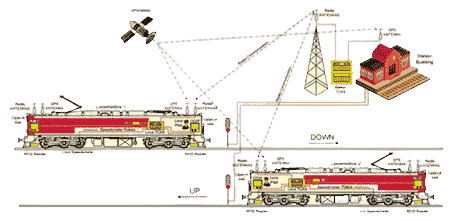Table of contents
Introduction
Kavach is a significant step forward in the development of India’s railway safety infrastructure. It is an indigenously developed system that is designed to prevent train accidents caused by human error and to improve the safety and efficiency of train operations. With the deployment of Kavach on all major railway lines, Indian Railways is poised to become one of the safest railways in the world.
What is Kavach system in railway?
Kavach, also known as Train Collision Avoidance System (TCAS), is an indigenously developed Automatic Train Protection (ATP) system by the Research Designs and Standards Organisation (RDSO) in collaboration with the Indian industry. It is a state-of-the-art electronic system with Safety Integrity Level-4 (SIL-4) standards, which means that it is extremely reliable and has a very low probability of failure.
Kavach is designed to prevent train accidents caused by human error, such as signal passing at danger (SPAD) and overspeeding. It also helps trains to operate safely in adverse weather conditions such as dense fog.
Benefits of Kavach
Kavach offers a number of benefits to Indian Railways, including:
- Improved safety: Kavach helps to prevent train accidents caused by human error, such as SPAD and overspeeding. This can significantly reduce the number of casualties and injuries caused by train accidents.
- Increased operational efficiency: Kavach helps trains to operate safely and efficiently in adverse weather conditions, such as dense fog. This can reduce delays and improve the overall reliability of train services.
- Reduced costs: Kavach can help to reduce the costs associated with train accidents, such as damage to rolling stock and infrastructure, as well as compensation payments to victims and their families.
How Kavach system works?
Kavach uses a combination of GPS, wireless communication, and onboard computers to regulate and monitor train movements. It consists of two main components:
• Trackside equipment: This includes balises (transponders) installed along the track at regular intervals, and radio frequency identification (RFID) tags at stations.
• Onboard equipment: This includes a GPS receiver, a wireless communication system, and a computer installed on the locomotive.
The onboard equipment continuously monitors the train’s location and speed, and receives signals from the trackside equipment. The computer then calculates the train’s movement authority (MA), which is the safe speed and distance at which the train can travel.
If the train exceeds its MA, or if it approaches a red signal, Kavach will automatically apply the brakes. This ensures that the train stops at a safe distance from the signal or from any other obstacle ahead.
Kavach also provides the loco pilot with a number of other features, such as:
• In-cabin signal display: This provides the loco pilot with a real-time display of the signals ahead, even in foggy or low visibility conditions.
• Overspeed warning: Kavach warns the loco pilot if the train is exceeding its speed limit.
• Emergency stop: Kavach can be used to bring the train to a quick halt in an emergency situation.
Implementation of the Kavach System
The Kavach system is being implemented in a phased manner on high-density routes and important sections across Indian Railways. The Railway Board has set a target to bring 34,000 km of the network under Kavach by 2027-28.
As of November 2023, Kavach has been deployed on over 1,465 km of track and 121 locomotives.
The South Central Railway zone is the leader in Kavach implementation, with the system deployed on 684 km of track and 65 locomotives.
Other zones where Kavach has been deployed include:
- North Central Railway: 271 km of track and 27 locomotives
- Western Railway: 225 km of track and 21 locomotives
- North Western Railway: 157 km of track and 11 locomotives
- East Central Railway: 102 km of track and 11 locomotives
Budget & Future Plan
The cost of implementing the Kavach system is approximately Rs 50 lakh per km for trackside equipment and Rs 70 lakh per loco for onboard equipment. The Railway Board has allocated a budget of Rs. 710.12 crore for the implementation of Kavach in the financial year 2023-24. The system is expected to be deployed on all major railway lines within the next few years.
The budgetary allocation for Kavach in FY 2023-24 is expected to be used for the following purposes:
- Deployment of Kavach on new routes: The Railway Board has set a target to bring 34,000 km of network under Kavach by 2027-28. The budgetary allocation for FY 2023-24 will be used to deploy Kavach on new routes and to complete the deployment of Kavach on routes where the system is already partially implemented.
- Upgradation of existing Kavach equipment: The Railway Board is also investing in the upgradation of existing Kavach equipment to ensure that it remains state-of-the-art. The budgetary allocation for FY 2023-24 will be used to fund these upgradation activities.
- Research and development: The Railway Board is also supporting research and development in the field of train safety. The budgetary allocation for FY 2023-24 will be used to fund these research and development activities.
Kavach Manufacturer
The Kavach system is indigenously developed by the Research Designs & Standards Organisation (RDSO) under Indian Railways, along with three private companies:
- HBL Power Systems
- Kernex Microsystems
- Medha Servo Drives
These three companies have been licensed by RDSO to manufacture and supply the Kavach system.
HBL Power Systems has won multiple contracts for the supply of Kavach, including the first contract under the Mission Raftar project. Kernex Microsystems has also received orders for the supply of Kavach, and Medha Servo Drives is currently conducting trials of an advanced version of the system.
